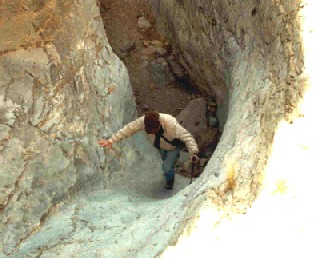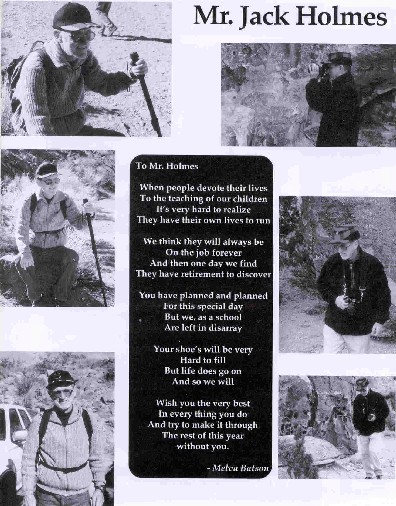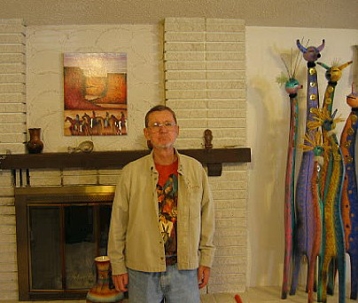Teacher Formulates A Lesson Plan Against Mesothelioma
Jack Holmes had always enjoyed good health. He and his wife, Elaine are both retired educators. Since 1964, Jack has taught mathematics to middle school and junior high students in Las Vegas. He retired in 1997.
The Holmes' enjoy the outdoors, hiking and camping. According to Jack, their whole recreational life has evolved into the study, discussion, and exploration of Native American rock art. They belong to the American Rock Art Association, the Nevada Rock Art Foundation, the Southern Nevada Rock Art Association, the Utah Rock Art Association and the Nevada Archaeological Associa-tion. Until recently they had belonged to archeological associations in Arizona and Colorado.
Elaine writes articles and submits them to rock art organizations for publication in their annual journals. She also presents some of these papers at their symposiums
Their hobby requires them to hike long distances and be ready to climb rock faces and hills.
In October, 2002, Jack began to experience unusual shortness of breath while hiking in western Nevada. He ignored his discomfort and finished the hike. In early November, 2002, chest films were taken in preparation for a vitrectomy at Sunrise Hospital in Las Vegas. (A vitrectomy is a procedure to clear blood and debris from the eye, remove scar tissue, or alleviate traction). A radiologist advised Jack that the films indicated he had "asbestos in your lungs" but suggested no follow-up.
Jack's shortness of breath continued. In January, 2003, he presented to Mountainview Hospital in Las Vegas with complaints of shortness of breath, lack of appetite, and an "over-filled stomach." A chest film revealed a right-sided pleural effusion.
On February 19, a day after his admission to Mountainview Hospital, Jack underwent a right-sided thoracentesis. The procedure produced 1100 cc's of brown, cloudy fluid. Cytological tests revealed the presence of atypical cells which were suspicious for a malignant process.

On February 23, Jack underwent a bronchoscopy and right thoracotomy at Mountainview. While in the chest cavity, his surgeon noticed a large "rind" on the lung. He then performed a decortication and talc pleurodesis. Pathological tests upon tissue biopsied from the surgery resulted in the diagnosis of malignant mesothelioma, biphasic type. One of the pieces of tissue which tested positive for malignant mesothelioma was a piece of pleural plaque. Jack remained hospitalized at Mountainview until his discharge on February 27.
Upon hearing the diagnosis, Jack was concerned about no longer being able to pursue his hobby, but more so about Elaine. He stated:
"These rock art sites are mostly in remote areas. Many require four-wheel drive just to get to a hiking point. It is dangerous to do that alone. A partner is needed . . . Elaine is a published author in this area and she will lose my help to find, get to and study these sites. She will also lose my companionship at meetings, conferences and on field trips. I can no longer do this strenuous hiking."
After his discharge, Jack met with a local oncologist at the Nevada Cancer Center. The doctor recommended chemotherapy utilizing Alimta and Cisplatin. Unfortunately, the oncologist had not completed the lengthy paperwork required by Eli Lilly. My office directed Jack and Elaine to Dr. Elber Comacho at the Desert Regional Medical Center in Palm Springs. Dr. Comacho and his staff were already administering Alimta on a compassionate use basis.
On April 1, Jack underwent his first Alimta treatment at Desert Regional. Each treatment takes place every three weeks. Jack and Elaine drive to Palm Springs for his chemotherapy. The 600-mile round trip leaves Jack exhausted and in pain.
During the treatments, Jack continued to hike to rock art sites. A CT scan in September of 2003 showed enlarged nodules around the lung. His oncologist began treating him with cisplatin and gemcitabine.
Jack has lost about 22 pounds since his diagnosis. He remains positive but states "I do not have much energy or strength. My wife is carrying the house on her back. Hopefully, I will get stronger and carry more of my share."
We will continue to follow his hike to recovery.

Upon his retirement, his school gave him a tribute. Below is a note from one of his students:
To Mr. Holmes,
When people devote their lives
To the teaching of our children
It's very hard to realize
They have their own lives to run
We think they will always be
On the job forever
And then on day we find
They have retirement to discover
You have planned and planned
For this special day
But we, as a school
Are left in disarray
Your shoe's will be very
Hard to fill
But life does go on
And so we will
Wish you the very best
In every thing you do
And try to make it through
The rest of this year
without you.
- Melva Batson
*** POSTED SEPTEMBER 1, 2004 ***
An Update -- 4/8/05
Upon completion of his first cycle of Alimta, a CAT scan was taken which showed a reduction in one tumor, but an increase in a second tumor. The treatments were discontinued due to the negative reaction of the second tumor.
Jack then completed several rounds of SDX-102. After approximately six treatments, he again underwent examination. This time a lymph node was noted to have increased in size.
Jack has just completed his second treatment of cisplatin with gemzar. Dr. Nicholas Vogelzang of the Nevada Cancer Institute is now coordinating Jack's treatments. He is very grateful for Dr. Vogelzang and for the fact he no longer has to make the long drive to Desert Regional.
Jack's energy level is still not where it was before his diagnosis, but Elaine continues to feed him and keep his strength up.
*** Mr. Jack Holmes passed away on December 24, 2005 ***

